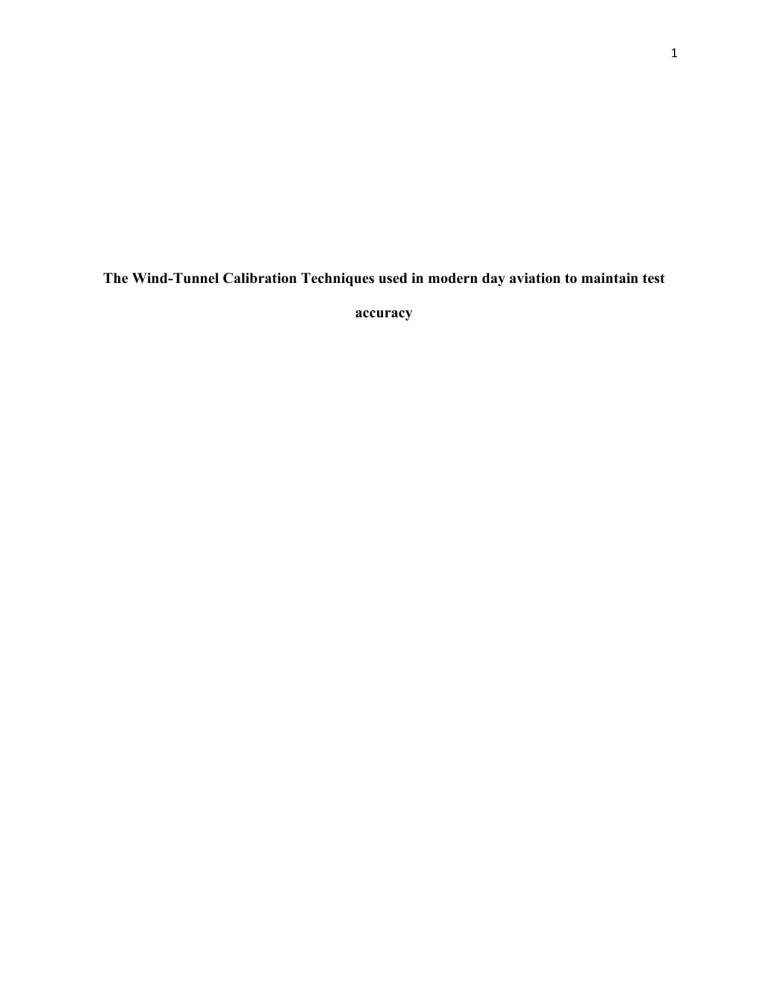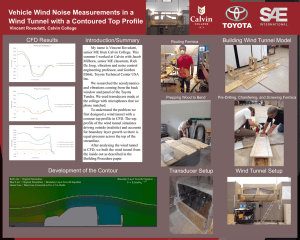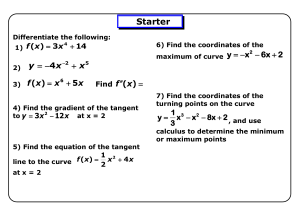the-wind-tunnel-calibration-techniques-used-in-modern-day-aviation-to-maintain-test-accuracy
advertisement

1 The Wind-Tunnel Calibration Techniques used in modern day aviation to maintain test accuracy 2 The Wind-Tunnel Calibration Techniques used in modern day aviation to maintain test accuracy A calibration determines the relation between the pressure at the head holes of the probe and the velocity and flow angle measured. Stagnation pressure and temperature, velocity or Mach number, and flow angularity are the parameters basic to any wind-tunnel calibration. A clean free jet, a constant, homogenous air flow with low turbulence, is the basis of each calibration. In order to decrease turbulence, the compressed air flows into a settling chamber and then through multiple screens and a honeycomb flow straightener, creating a clean, homogenous air flow. Then the flow exits through specially built nozzles configured for minimal loss of pressure. For a standalone balance, without the existence of the wind tunnel itself, the static calibration of the balance can be achieved. It is much easier to do a calibration with the balance dismounted from the wind tunnel than to calibrate it attached to its tunnel mounting supports (“The Vectoflow calibration wind tunnel”, n.d.). As stated in the research of Gonzalez et. al in 2010, the wind tunnel balances, composed of many components of hardware and software, provide high precision and reliability for the measurements sought directly. The key parameters that characterize such systems are the range, precision and response time of the measurements. Wind tunnel balances are commonly used and are a suitable method for the acquisition of measurements, with a wide range of indicators and a rapid response to changes in loads. This system requires a substantial initial calibration effort, but the system can be used to evaluate several low-cost models with reduced effort once the measurements are known to be accurate. Pressure measurement at several model points by means of a pressure scanner or scan valve system is another method for aerodynamic load measurement. A very complex and costly test model is needed for such a method. By making 3 holes and connecting them with the scan valve through a tube that transmits the pressure, the measurement points are built into the model surface. These holes often introduce changes in the flow around the model, thus changing the model's actual behavior. A balance support is required to correct the balance to the structure of the wind tunnel, in addition to the model supports. These supports are positioned outside the test chamber of the wind tunnel, so their dimensions and weight are not essential, and a high stiffness is the requirement imposed on them. External balances are mounted outside the model, within or outside the test section of the wind tunnel chamber, and some disturbance in the wind flow is often added. However, the prospect of modifying test models with almost no effort provides the wind tunnel facility with a high degree of versatility. For these balances, there are many degrees of difficulty, depending primarily on the number of channels of measurement, which may differ between 1 and 6. The external balances are used as a fixed feature of the wind tunnels, but the interchangeable items are the test versions. The mechanical connection between the balance and the model is the model support system. Internal balances are mounted within the model; thus, no intervention by the balance components is inserted in the wind flow, but a mechanical support for the model is still required to stabilize it in the test chamber and, if necessary, adjust the orientation of the model. As the balance has to be mounted inside, the complexity of the test model is comparable or higher than the models for scan valve systems. Thus, in evaluating various models, this choice does not provide versatility. These balances are typically sent to the already calibrated customer and to the acquisition method. Also, the number of components measured can vary between 1 and 6. 4 Rotary balances are used for propellers, helicopter blades and other rotating models. The reverse principle of balance design is a complete mechanical decoupling of the components of the 6 loads. A unidirectional load signal (traction-compression) will be the output of each channel, and the rise, drag, lateral forces and pitching, balance, yawing impulses will be the composition of the signals. To obtain the lift force (which is the dominant force in aeronautical applications), the pitching momentum and the balance momentum, two horizontal sensors in the direction of wind flow to acquire the drag force and the yawing momentum, and one horizontal sensor perpendicular to the direction of flow to calculate the lateral forces, one option may be to use three vertical sensors (Gonzalez et. al, 2010). The economic advantage of providing an optimum choice of engine for a given aircraft configuration and the increased criteria for emission reduction is one of the drivers of increased precision in scaling methodology. In the aircraft program, the scaling effects may introduce a potential risk, especially for large wings designed for high subsonic Mach numbers. A study of the scale and Reynolds number effects could dramatically increase the cost of production if they were to be performed only in the wind tunnel. It may, therefore, be economically advantageous to use CFD methods as a complement to wind tunnel testing. The high precision of the wind tunnel results and the detailed data set (capable of free flight Reynolds and Mach number) from the CFD calculations both complement each other with modern wind tunnel testing techniques and CFD methods, allowing a thorough investigation of flow topology and phenomena (Mosbah, 2013). In an objective sense, the CFD calculations could not provide the "right answer," but it should perhaps be assumed to provide a solution within a reasonable bound of accuracy. However, it was pointed out that CFD can very well compute delta drag levels between similar 5 configurations and that this was how CFD was commonly used for aircraft design and production in the industry. The EGD, introduced by Dueck, algorithm functions as simulated annealing (SA), but to achieve the local minimum, it accepts worse solutions than SA. In order to control the pressure distribution, the hybrid NN-EGD system is suggested by adjusting the point coordinates within the test chamber, wing speed and temperature. To achieve an optimum network configuration such that the error is as minimal as possible, the EGD algorithm is used. Fluent software is used to assess the pressure values within the test chamber to train and test the NN. The inputs of the model are the coordinates (x, y, z), the wind velocity (V) and the temperature (T) of the test chamber, while the outputs are the pressure. The goal was to obtain the simplest configuration in a short compilation period to give the best results. According to the coordinates of each point, the wind speed and the temperature of the test chamber, researchers can successfully obtain the value of the pressure at each point in the dataset by using this method. Conventional hot-wire probes are designed to minimize these thermal feedback effects by the use of large length to diameter ratios that reduce conduction end losses. Using sensitivities derived from static calibrations, dynamic measurements can therefore be made. It is important to perform separate dynamic calibrations for changed wires and films. One such approach was to compare the boundary-layer turbulence measurements obtained with the typical traditional hot wire, the epoxy-backed wire, the identical ceramic wedge-supported wire, and two commercially available hot film probes (Mosbah, 2013). According to Reed et. al, newer optical methods for flow visualization include laser Doppler velocimeters (LDV), holographic velocimeters (HV), and holographic interferometry (HI) for density measurements. For density measurements, modern optical methods for flow 6 visualization include laser Doppler velocimeters (LDV), holographic velocimeters (HV) and holographic interferometry (HI). The key benefit of LDV's and HV's is their ability to calculate three-dimensional fields of flow without affecting the flow. This is especially important in transonic tunnels near Mach one. For quantitative measurements of low-speed velocity fields near models, the utility of Laser Streak Velocimetry (LSV). In comparison to the point-by-point measurements required with LDV's, this technique has the advantage of providing speeds on a plane at the same time. However, for empty-tunnel calibrations, the precision of LSVs is currently inadequate. Measurement of the force on a "pressure plate" or drag plate at the same time as the flow velocity. During the observation of the force on the pressure plate, this method permitted the determination of the flow velocity. The method of data acquisition is amplified by many devices that help physical forces to be transformed into digital values that can be connected to the server. The mechanics must also ensure that no friction forces occur and that such unnecessary loads are avoided. The sensors are instruments that transform an electrical signal into a physical load. Depending on the characteristics of the load and the sensor itself, the capacity of the sensors to calculate the power. There are several forms of transducers. Load cells that create the electrical signal by means of the mechanical deformation that generates the force applied. In order to provide a distinguishable signal in the analog to digital converter, the sensor output signal is a weak signal of about a few millivolts and its power has to be increased by means of an amplifier. The electrical signal is transferred from the sensor to the amplifier and from the amplifier to the sensor through highquality and efficient wires. The analog to digital converter (ADC) transforms an analog continuous signal (voltage or current) into a digital discrete time signal. Software programs at the 7 end of the data acquisition process that post-process the signal measurements to obtain the values of forces and momentums. 8 REFERENCES Amaya, M. A., & Boone, A. R. (n.d.). 643646main_AIAA2005_4277 [PDF]. Moffett Field, CA: NASA Ames Research Center. Ben Mosbah, A., Flores Salinas, M., Botez, R., & Dao, T. (2013). New methodology for wind tunnel calibration using neural networks - egd approach. SAE International Journal of Aerospace, 6(2), 761-766. doi:10.4271/2013-01-2285 Gonzalez, M., Ezquerro, J. M., Lapuerta, V., Laveron, A., & Rodriguez, J. (2011). Components of a wind tunnel balance: Design and calibration. Wind Tunnels and Experimental Fluid Dynamics Research. doi:10.5772/21095 The importance of wind tunnel testing in the lab. (2016, March 24). Retrieved February 08, 2021, from https://sea.omega.com/ph/technical-learning/importance-of-wind-tunneltesting-in-the-lab.html Owen, K., & Owen, A. (2012). Measurement and assessment of flow quality in the national transonic wind tunnel. 50th AIAA Aerospace Sciences Meeting including the New Horizons Forum and Aerospace Exposition. doi:10.2514/6.2012-320 Pettersson, K. (2006, September). Scaling Techniques Using CFD and Wind Tunnel Measurements for use in Aircraft Design [PDF]. Rautenberg, A., Allgeier, J., Jung, S., & Bange, J. (2019, March 07). Calibration procedure and accuracy of wind and TURBULENCE measurements With five-hole probes on FIXED- 9 WING unmanned aircraft in the atmospheric boundary layer and wind Turbine wakes. Retrieved February 08, 2021, from https://www.mdpi.com/2073-4433/10/3/124/htm Reed, T. D., Pope, T. C., & Cooksey, J. M. (1977, November). 42875618 [PDF]. Dallas. The Vectoflow calibration wind tunnel. (n.d.). Retrieved February 08, 2021, from https://www.vectoflow.de/en/technology/calibration-windtunnel/#:~:text=A%20calibration%20defines%20the%20relationship,by%20our%20calibra tion%20wind%20tunnel. Wind tunnel testing. (2015, May 5). Retrieved February 08, 2021, from https://www.grc.nasa.gov/www/k-12/airplane/tuntest.html




